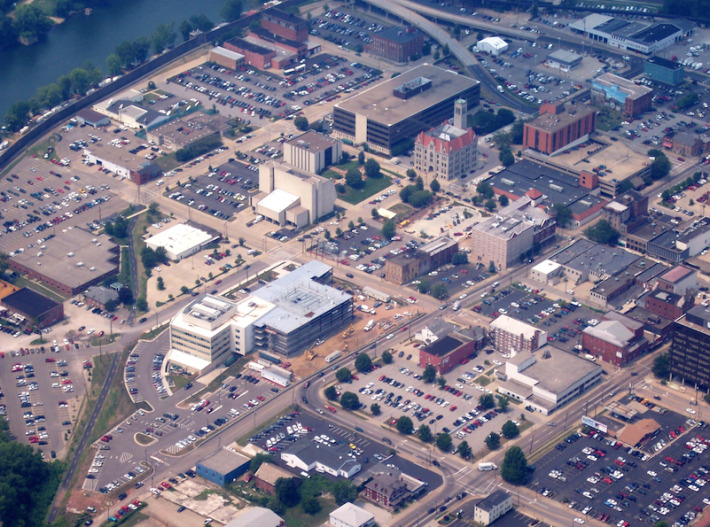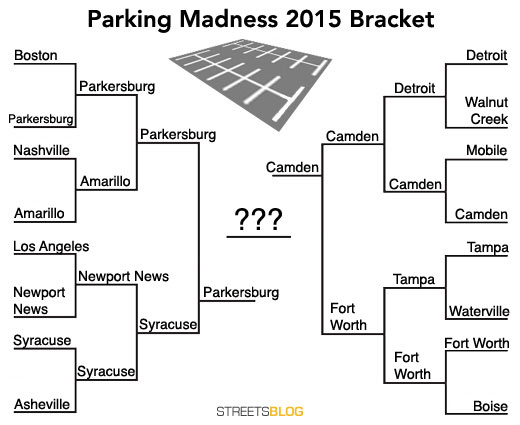Welcome to the World Series of asphalt. The Super Bowl of lifeless city blocks. Today is the Parking Madness championship -- the culmination of our 16-city tournament showcasing the worst parking craters to scar America's downtowns.
Are you excited? We are!
Streetsblog readers have winnowed the field down to two of the finest examples of poor urban land use you can find. When every level of government spends year after year prioritizing the movement and storage of cars, this is what you end up with.
Now there's just one more vote to determine which city deserves the Golden Crater and the shame that comes with it (change-inducing shame, hopefully). Voting wraps up at 2 p.m. Eastern time tomorrow, and we'll conclude this year's tournament with commentary from special guest -- drumroll, please -- Donald Shoup!
Camden
Camden squashed Mobile, Detroit, and Fort Worth in earlier rounds to reach the championship match. Joseph Russell nominated this parking crater. He explains:
My entry: the neighborhood-killing parking lots on the waterfront in Camden, New Jersey. Years ago, this area housed factories for companies like RCA. Ever since, they've been used as parking lots for the equally neighborhood-deadening L3 Building, which is essentially a fortress separating employees from the rest of the city. Residents of the Cooper-Grant neighborhood are trying to rebuild a viable neighborhood here, and the negative effects of these huge parking lots stand directly in the way of that goal.
Is it Golden Crater worthy? Let's check out the competition.
Parkersburg
Parkersburg has been a tournament darling, overcoming strong contenders in Boston, Amarillo, and Syracuse. The submitter of this photo, Elliott Lewis, said of this space:
Here is my submission for the Golden Crater, aptly named “Park”ersburg, WV. With a population around 31,000, it is the fourth-largest city in West Virginia and my hometown. This town has seen Native American raids on settlers (and vice versa), George Washington surveying, planned treason by Vice President Aaron Burr (check out the history of Blennerhassett Island), Civil War soldiers, some of the first governors of WV, Wright Brothers flights, birth of the country’s oil and gas industry, important transportation hubs, large-scale hardware and chemical manufacturing, and countless historical events. Those which took place downtown are likely under asphalt (like the home of the first governor of our state).
By my calculations, including street and sidewalk ROWs, the total amount of land in downtown Parkersburg is approximately 61% paved. Of the developable land in this same area (not counting streets), about 50% is dedicated surface parking, most of which is monthly rentals. Yup, the only short term parking is on-street, in one garage, or in a newly-built parking lot off of 6th St. They dedicate half their land to surface parking. Ugh.
The area in question, besides the entire downtown area, is that from 4th Street to the Little Kanawha River. Much of this is dominated by City, County, and Federal government services and includes the County Courthouse (beautiful Romanesque revival) and the Municipal Building (no so beautiful). From the Google Maps link, it shows some buildings currently demolished; the entire block between Juliana/Market/1st/2 is paved, as will the building across Market Street abutting 2nd St (the old jail). And to make matters more depressing, the area is bounded by elevated railroad tracks near Ann St., an at-grade railway, and a concrete floodwall.
Who will win the ultimate wake-up call to fix its parking mistakes? Vote and decide:








